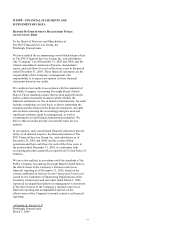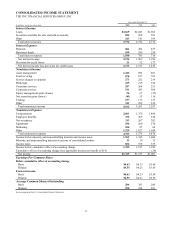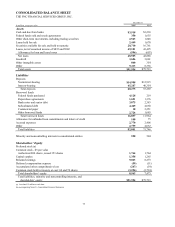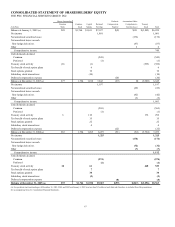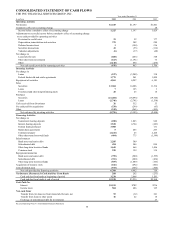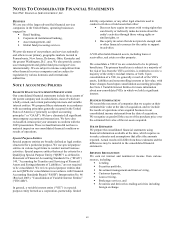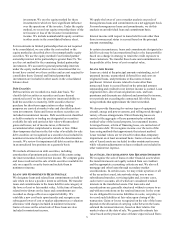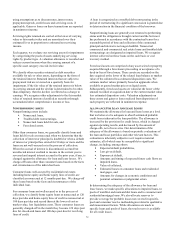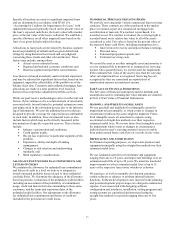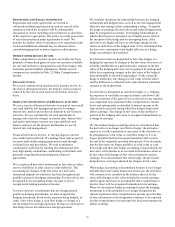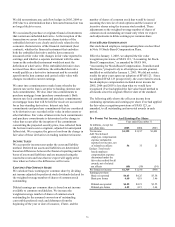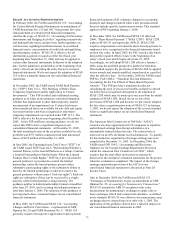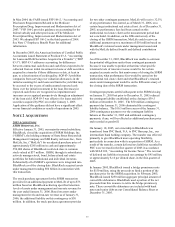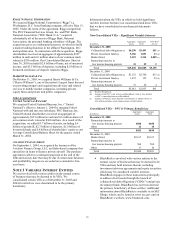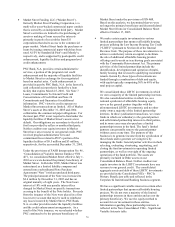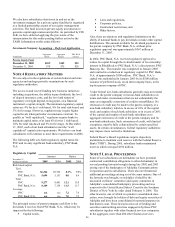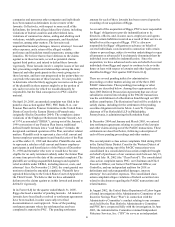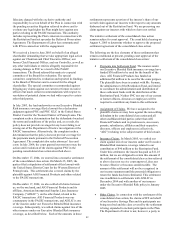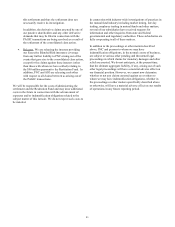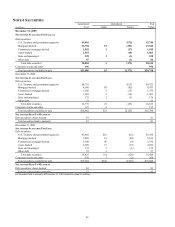PNC Bank 2005 Annual Report Download - page 74
Download and view the complete annual report
Please find page 74 of the 2005 PNC Bank annual report below. You can navigate through the pages in the report by either clicking on the pages listed below, or by using the keyword search tool below to find specific information within the annual report.74
REPURCHASE AND RESALE AGREEMENTS
Repurchase and resale agreements are treated as
collateralized financing transactions and are carried at the
amounts at which the securities will be subsequently
reacquired or resold, including accrued interest, as specified
in the respective agreements. Our policy is to take possession
of securities purchased under agreements to resell. We
monitor the market value of securities to be repurchased and
resold and additional collateral may be obtained where
considered appropriate to protect against credit exposure.
OTHER COMPREHENSIVE INCOME
Other comprehensive income consists, on an after-tax basis,
primarily of unrealized gains or losses on securities available
for sale and derivatives designated as cash flow hedges, and
minimum pension liability adjustments. Details of each
component are included in Note 22 Other Comprehensive
Income.
TREASURY STOCK
We record common stock purchased for treasury at cost. At
the date of subsequent reissue, the treasury stock account is
reduced by the cost of such stock on the first-in, first-out
basis.
DERIVATIVE INSTRUMENTS AND HEDGING ACTIVITIES
We use a variety of financial derivatives as part of our overall
asset and liability risk management process to manage
interest rate, market and credit risk inherent in our business
activities. We use substantially all such instruments to
manage risk related to changes in interest rates. Interest rate
and total return swaps, interest rate caps and floors and
futures contracts are the primary instruments we use for
interest rate risk management.
Financial derivatives involve, to varying degrees, interest
rate, market and credit risk. We manage these risks as part of
our asset and liability management process and through
credit policies and procedures. We seek to minimize
counterparty credit risk by entering into transactions with
only high-quality institutions, establishing credit limits, and
generally requiring bilateral netting and collateral
agreements.
We recognize all derivative instruments at fair value as either
assets or liabilities in other assets or other liabilities. The
accounting for changes in the fair value of a derivative
instrument depends on whether it has been designated and
qualifies as part of a hedging relationship. For derivatives not
designated as an accounting hedge, the gain or loss is
recognized in trading noninterest income.
For those derivative instruments that are designated and
qualify as hedging instruments, we must designate the
hedging instrument, based on the exposure being hedged, as
either a fair value hedge, a cash flow hedge or a hedge of a
net investment in a foreign operation. We have no derivatives
that hedge the net investment in a foreign operation.
We formally document the relationship between the hedging
instruments and hedged items, as well as the risk management
objective and strategy before undertaking a hedge. To qualify
for hedge accounting, the derivatives and related hedged items
must be designated as a hedge. For hedging relationships in
which effectiveness is measured, we formally assess, both at
the inception of the hedge and on an ongoing basis, if the
derivatives are highly effective in offsetting changes in fair
values or cash flows of the hedged item. If it is determined that
the derivative instrument is not highly effective as a hedge,
hedge accounting is discontinued.
For derivatives that are designated as fair value hedges (i.e.,
hedging the exposure to changes in the fair value of an asset or
a liability attributable to a particular risk), changes in the fair
value of the hedging derivative are recognized in earnings and
offset by recognizing changes in the fair value of the hedged
item attributable to the risk being hedged. To the extent the
hedge is ineffective, the changes in fair value will not offset
and the difference is reflected in the same financial statement
category as the hedged item.
For derivatives designated as cash flow hedges (i.e., hedging
the exposure to variability in expected future cash flows), the
effective portions of the gain or loss on derivatives are reported
as a component of accumulated other comprehensive income
(loss) and subsequently reclassified in interest income in the
same period or periods during which the hedged transaction
affects earnings. The change in fair value of any ineffective
portion of the hedging derivative is recognized immediately as
a charge to earnings.
We discontinue hedge accounting when it is determined that
the derivative is no longer an effective hedge; the derivative
expires or is sold, terminated or exercised; or the derivative is
de-designated as a fair value or cash flow hedge or it is no
longer probable that the forecasted transaction will occur by
the end of the originally specified time period. If we determine
that the derivative no longer qualifies as a fair value or cash
flow hedge and therefore hedge accounting is discontinued, the
derivative will continue to be recorded on the balance sheet at
its fair value with changes in fair value included in current
earnings. For a discontinued fair value hedge, the previously
hedged item is no longer adjusted for changes in fair value.
When hedge accounting is discontinued because it is no longer
probable that a forecasted transaction will occur, the derivative
will continue to be recorded on the balance sheet at its fair
value with changes in fair value included in current earnings,
and the gains and losses in accumulated other comprehensive
income (loss) will be recognized immediately into earnings.
When we discontinue hedge accounting because the hedging
instrument is sold, terminated or no longer designated, the
amount reported in other comprehensive income up to the date
of sale, termination or de-designation continues to be reported
in other comprehensive income until the forecasted transaction
affects earnings.


